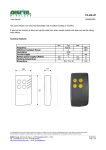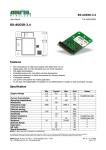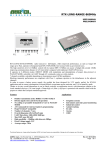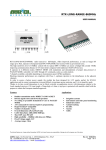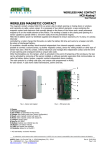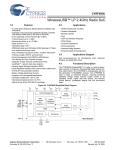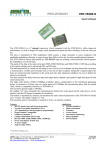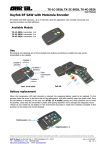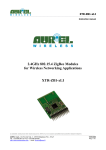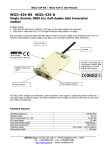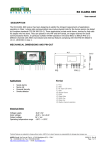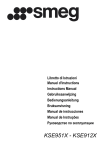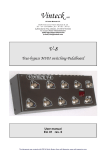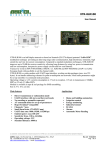Download XTR VF 2.4 HP/V
Transcript
DATASHEET XTR VF 2.4 HP/V --------------------------------------------------------------------------------------------------------------------------------------------------- XTR VF 2.4 HP/V Very Fast Low Power Multichannel Transceiver equipped with power amplifier Picture has been made from a sample. The real shape could change based on latest release. DESCRIPTION Long range transceiver XTR VF 2.4 HP/V is pin-to-pin compatible with previous models • XTR VF 2.4 LP • XTR VF 2.4 PA-LNA representing an extension suitable to reach a RF output power (ERP) increate up to 18dBm (compared with the 4 dBm of the XTR VF 2.4 LP). In this way it’s possible to cover in open space outdoor conditions, a radio link of 200 meters. In case the final application needs to use a battery powered device, and a very low power steady consumption, two version (XTR VF 2.4 LP and XTR VF 2.4 HP/V) are fully compatible simply by providing some additions to the SW (see dedicated paragraph). It operates in the License Free Industrial, Scientific and Medical (ISM) band at 2.4GHz and it offers a complete radio module solution for integration into existing or new 2.4GHz products. It uses a DSSS (Direct Sequence Spread Spectrum) technique that allows operation in disturbed environments and that reduces the interference caused by traditional narrowband signals. This technique also allows coexistence with Bluetooth and Wi-Fi as well as all other wireless technologies that utilize the 2.4GHz ISM Band. Transceiver embeds a front-end power amplifier for transmission, and a Low Noise Amplifier to clear up the signal received. Module can be connected to a micro controller and one or more external devices via SPI Interface. This last facility makes possible full transceiver programmability: in particular, possibility is given to set RF channel, data transmission speed and RF radiated power level. Thanks to the power amplifier, output power could achieve 18 dBm (step from -10 to +18dBm). RF channels available are 76 and Transmission range is selectable from 16Kbit/sec to 250Kbit/sec according to the used spreading code. It can be increased to 1Mbit/sec if spread spectrum technique is not used. Technical features are subject to change without notice. AUR°EL S.p.A does not assume responsibilities for any damage caused by the device’s misuse.. --------------------------------------------------------------------------------------------------------------------------------------------------------------------AUREL S.p.A. Via Foro dei Tigli, 4 - 47015 Modigliana (FC) – ITALY 18/06/2014 - Rev.B Pag 1 di 4 Tel.: +39.0546.941124 Fax: +39.0546.941660 http://www.aurelwireless.com - email: [email protected] DATASHEET XTR VF 2.4 HP/V --------------------------------------------------------------------------------------------------------------------------------------------------- Actually AUREL has develop 3 different versions based on different HW features: - XTR VF 2.4 HP/V, (90° pinout frame, Antenna PIFA printed on PCB) - XTR VF 2.4 HP/H-AI (pinout frame straight, Antenna PIFA printed on PCB) - XTR VF 2.4 HP/H-AE (pinout frame straight, esternal Antenna ULF conncetor) NOTE: Since MAY 2014 Aurel produce this version. Previous family PA-LNA version are totally replaced in term of pinout, overall dimension, technical features, performances, and user command. Application Irrigation Systems Industrial Automation Access control Road Works Lighting Long Distance Data Collection Environment Telemetry Pin out VCC 2 1 GND nRESET 4 3 IRQ nSS 6 5 MOSI MISO 8 7 SCK NC 10 9 GND NC 12 11 NC Pin out description Pin Description 1,9 GND GND connection 2 VCC Positive Voltage supply connection 3 IRQ Interrupt signal from the radio module to an external microcontroller 4 nRESET 5 MOSI Master Out Slave In. SPI signal from an external microcontroller to the radio module. 6 nSS Slave Select signal (active low) from an external microcontroller to the radio module Reset signal (active high) from an external microcontroller to the radio module Technical features are subject to change without notice. AUR°EL S.p.A does not assume responsibilities for any damage caused by the device’s misuse.. --------------------------------------------------------------------------------------------------------------------------------------------------------------------AUREL S.p.A. Via Foro dei Tigli, 4 - 47015 Modigliana (FC) – ITALY 18/06/2014 - Rev.B Pag 2 di 4 Tel.: +39.0546.941124 Fax: +39.0546.941660 http://www.aurelwireless.com - email: [email protected] DATASHEET XTR VF 2.4 HP/V --------------------------------------------------------------------------------------------------------------------------------------------------- 7 SCK 8 MISO SPI clock from an external microcontroller to the radio module Master In Slave Out. SPI signal from the radio module to an external microcontroller Technical specifications Features Min Voltage Supply 2.0 Current supply (RX mode) Current supply (Tx mode step 6) Tip Max Unit 3.6 V 31 100 Current supply (Tx mode step 4) Current supply (Standby mode) 2 Modulation type GFSK Receiver sensitivity @250kbit/s -100 mA 130 mA 80 mA uA dBm RF power out (ERP) (1)(2) -10 18 dBm RF channels frequencies 2404 2480 MHz RF bandwith Operating temperature 1 0 MHz +70 °C (1) Posted values point out an E.R.P. power for version with the PIFA integrated antenna, and power available on the antenna connector UFL in case of version with external antenna. (2) To be in compliance with the EUROPEAN standard requirements, max. output power level is 10mW (reference rule EN 300 328). This condition is satisfied with step n°4 of 0x03 register. Using step n°6 of that register, will obtained the max output power +18dBm. Please note to don’t use the step n°7 Reference Rules and reference documentation XTR VF 2.4 HP/V modules fully satisfies the European legislations EN 300-328 and EN 301-489 with max. power supply of 3.6V. Products are tested following the directive EN 60950 and it can be used inside a dedicated insulated containers, assuring the harmony with the above standards. Module must be powered by a very low Voltage source, protected against the short circuits. If Modules are incorporated into a product the Users must ensure the antenna insulation, due output RF transmitter can’t support directly the static charges foreseen by the EN 61000-4-2 standards.Modules can be installed inside containers that assuring the surpassing of EN 61000 standards, are not directly applicable to it. For information on technical details of XTR VF 2.4 LP such as register settings, timing, application interfaces, clocking and power managing, refer to the data sheet of the CYRF6936 Radio SoC on Cypress internet site: www.cypress.com. Technical features are subject to change without notice. AUR°EL S.p.A does not assume responsibilities for any damage caused by the device’s misuse.. --------------------------------------------------------------------------------------------------------------------------------------------------------------------AUREL S.p.A. Via Foro dei Tigli, 4 - 47015 Modigliana (FC) – ITALY 18/06/2014 - Rev.B Pag 3 di 4 Tel.: +39.0546.941124 Fax: +39.0546.941660 http://www.aurelwireless.com - email: [email protected] DATASHEET XTR VF 2.4 HP/V --------------------------------------------------------------------------------------------------------------------------------------------------- Firmware additions compared with the previous module Aurel XTR VF 2.4 LP XTR VF 2.4 HP/V, compared to the previous mododule XTR VF 2.4 LP, introducea power amplifier (PA) and a Low Noise Amplifier (LNA). These additional components are managed inside the module itself through the lines PACTL/GPIO (pin 30) e XOUT/GPIO (pin 29) of the CYRF6936. Therefore, it’s necessary to programm the CYRF6936 to use these lines as GPIO and drive them properly. At device inizialization time, it’s necessary to setup XOUT and PACTL as GPIO and setup as low output as follow: setting XOUT as GPI0: Register 0x0C => Bit 6 = Bit 7 = 1 setting PACTL as GPIO: Register 0x0D => Bit 2 = 1 setting XOUT and PACTL as standard CMOS Output Register 0x0D => Bit 3 = Bit 4 = 0 Output setting XOUT and PACTL to value 0: Register 0x0E => Bit 5 = Bit 7 = 0 XOUT and PACTL management is different depending if device is in transmission, in reception or in power down, as follow: Transmission Before to activate the transmission, it’s necessary to switch on the Power amplifier Therefore before to lift up TX GO bit on register 0x02, it’s necessary perform the following operation: Register 0x0E => Bit 5 = Bit 7 = 1 meaning PACTL and XOUT = 1 Reception Before to activate the reception, it’s necessary to switch on the Low Noise Amplifier Therefore before to lift up RX GO bit on register 0x05, it’s necessary perform the following operation: Register 0x0E => Bit 5 = 0 , Bit 7 = 1 meaning PACTL = 0 and XOUT = 1 Power Down In order to obtain a low concumption, it’s necessary disable both PA and LNA. Therefore before to put the device in power down or Idle mode, it’s necessary perform the following operation: Register 0x0E => Bit 5 = Bit 7 = 0 meaning PACTL = XOUT = 0 Technical features are subject to change without notice. AUR°EL S.p.A does not assume responsibilities for any damage caused by the device’s misuse.. --------------------------------------------------------------------------------------------------------------------------------------------------------------------AUREL S.p.A. Via Foro dei Tigli, 4 - 47015 Modigliana (FC) – ITALY 18/06/2014 - Rev.B Pag 4 di 4 Tel.: +39.0546.941124 Fax: +39.0546.941660 http://www.aurelwireless.com - email: [email protected]




